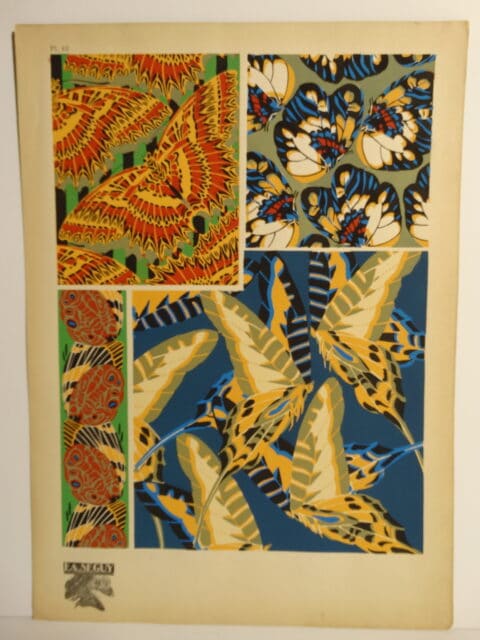Description
Emile-Alain Seguy Pochoir Butterfly 1924-Sourced from a Papillons Portfolio
This desirable antique butterfly design is available to purchase. You can buy Seguy Papillons Patterns PL19 with our buy it now option. Emile Allain Séguy, and E.A. Seguy is also known as Eugène Séguy. He rendered the Papillons (or Butterflies in English) in 1924. The designs were used for all kinds of textiles including wall paper. Intense coloration is the result of using metallic & mineral components in the paints. Characteristic of French pochoir painting technique. Each color was applied by individual stencils. A large rounded brush of was used to apply the paint liberally (thick). A complete set of Papillons has 20 total plates to a portfolio. 16 butterfly plates plus 4 plates of geometric patterns of butterflies.
E.A. Seguy Artwork-Seguy Papillons Patterns PL19-Height of Art Deco
Seguy lived from 1877-1945. His life began just as the Art Nouveau movement began. His life ended at the same time as the Art Deco period ended. One of his finest creations was Papillons. It published at the height of Art Deco in Paris, France. They were printed by two companies: Duchartre & Van Buggenhoudt, both located in Paris. Portfolios were sold by galleries in Paris. Little information is known as to prices they sold for. Or how many were published and have survived. Furthermore little is known about the stores that sold these unusual design portfolios.
I speculate a small late night gallery in the Montmontre, near the Moulin Rouge. Located in the 18th Arrondissement, this was the heartbeat of the Paris scene. Fashion and the arts were at a worldwide height here. Women decked out in Art Deco dress. Men looking their best. Paris was the place to be. And the 18th Arrondissement in Paris was the place to buy great art.
Pochoir defined: the application of paint by stencil.
Pochoir is French for stenciling. In reality this ancient style of painting dates back some 1000 years to China. Utilizing this technique, adding colors to artwork is applied by individual stencils. A course rounded brush was used to apply each color. Furthermore by the 1890’s the coloration technique came to commercial publishing in Paris. It was also used in New York, Prague, London, Florence and in other Eastern European cities. Yet it was the French who mastered pochoir.
Emile-Alain Seguy is best known for his pochoir on his Butterflies and Insects. Respectively his portfolio works of art are entitled Papillons and Insectes. Both are incredible works of Parisian Art Deco. The plates date from 1924 to 1926. Each plate reflects the excitement experienced during the Art Nouveau & Art Deco periods in Paris, France.
Conclusions: owning Seguy Papillons Patterns PL19, original Pochoir art.
In conclusion Art Nouveau and Art Deco both utilized “nature” as common subject manner. Whereas the Seguy Papillons and Insectes have a single theme of butterflies of bugs. Seguy had a reverence for nature. This reverence is demonstrated in Seguy Papillons Patterns PL19. He conveyed this clearly through unparalleled designs, such as this particular piece. This antique Seguy print will take you back in time to the height of the Art Nouveau & Art Deco periods in Paris.
When you own an original piece of art you are owning a little piece in history. Seguy Papillons Patterns PL19 is part of French history. My father told me a really long time ago: “Anne, anyone can own a picture of the Mona Lisa.” Which literally meant to me that anyone can own a picture of the Mona Lisa, but it is never like owning the real one. When you own a piece of historic artwork such as this, you are living with a piece of history. It is a reflection of your interests in art and history and nature.
Learn more about E.A. Seguy and his work such as Seguy Papillons Patterns PL19. See additional available pieces from Papillons & Insectes. Please see my main page by clicking the link below. Thanks for visiting! Call with your questions. Anne 413-245-4197.
Seguy Insectes Papillons: Rare Pochoirs by Emile Allain Séguy




